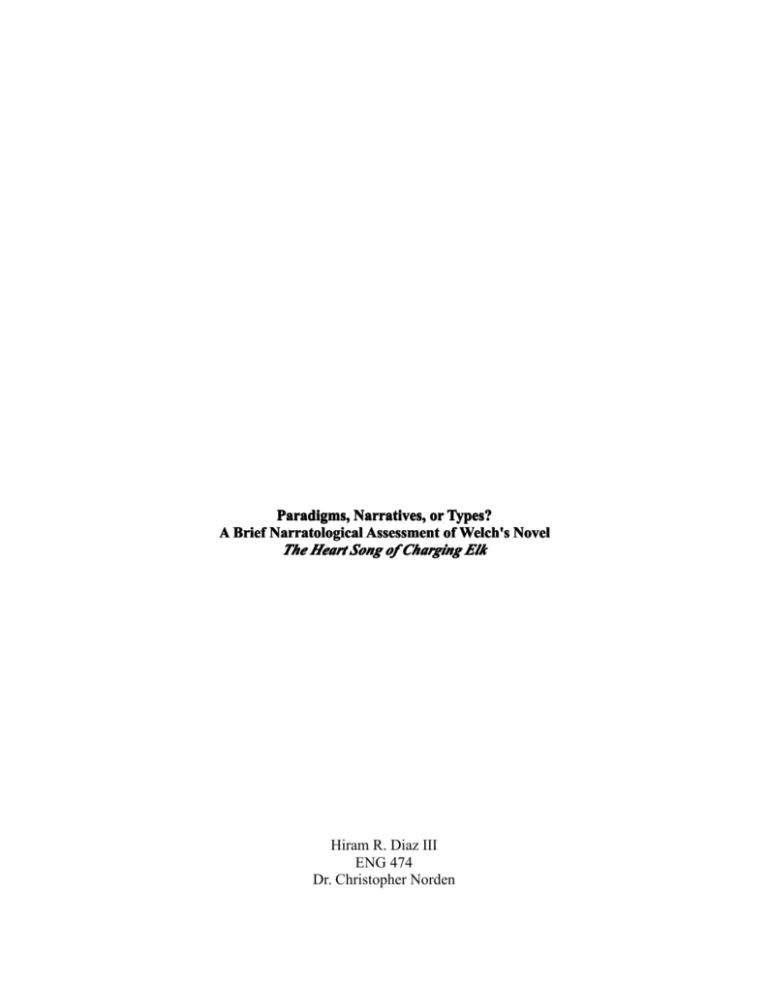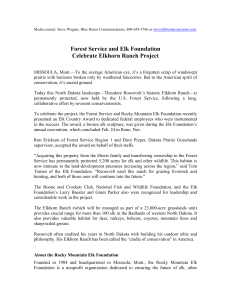Paradigms, Narratives or Types?
advertisement

Paradigms, Narratives, or Types? A Brief Narratological Assessment of Welch's Novel The Heart Song of Charging Elk Hiram R. Diaz III ENG 474 Dr. Christopher Norden Diaz 2 How Does One Render History Intelligible? "The model for historical intelligibility," writes theorist Jonathan Cullers, "is literary narrative.We make sense of events through possible stories...historical explanation follows not the logic of scientific causality but the logic of story."1 Science and Literature, then, constitute two very different explanatory modes. On the one hand, "...the paradigmatic [scientific] mode involves synchronic understanding via logical proof, empirical observation, and causal explanation;" whereas on the other hand, "...the narrative mode involves diachronic understanding via storied accounts of the 'vicissitudes of human intentions' [...] organized in time, [These are] explanations [...] in terms of believable narratives of actors—human and otherwise—striving to do things over time."2 The prima facie strength of this antithetical pair notwithstanding, there have, nevertheless, been "scientific" attempts to render history intelligible. In fact, "the most rigid of the scientific theories applies...the methods of natural science. They are reductionist in effect and may well be called non-historical theories of history."3 Non-narratival theorists believe that "observation of historical processes will disclose the laws of history just as nineteenth-century scientists believed that observation of physical processes would disclose the laws of physics.4 And while such theories are ultimately self-referentially absurd and fail to define which structural elements underpinning the processes of history are universal,5 they are still helpful in formulating a narratival approach to rendering history intelligible that is neither ateleologically circular nor unrealistically linear. For while linearity accounts for the composition and decomposition of material entities, circularity accounts for universal structural similitude between those entities; and yet linearity and circularity, as outlined above, are necessary, indispensable Diaz 3 presuppositions to the process of rendering history intelligible. A typological model successfully draws linearity and circularity together, as can be seen, I will argue, in James Welch's work The Heartsong of Charging Elk. The typological model articulated therein does not trivialize metaphysical and/or ethical criticisms by erasing the uniqueness of the present iteration of a given past experience, nor does it render present iterations of given past experiences completely unique and divorced from their corresponding genealogies. Mythology In contrast to modern approaches, mythology is perhaps the most primitive means of addressing quantitative and qualitative change. Vine Deloria Jr. notes that "every human society maintains its sense of identity with a set of stories that explain, at least to its satisfaction, how things came to be. [They] begin at a creation and carry forward a tenuous link of [presumably historical] events [...] actual experiences of the group that often serve as precedents for determining present and future actions."6 These stories, since the advent of the "scientific revolution" in general, and Darwin's doctrine of evolution in particular, have become dismissed as "myths," stories concocted by people groups of an earlier, less intellectually enlightened time. Deloria, perhaps rightly, believes that Christianity's pre-Darwin prominence, and post-Darwin diminution, has contributed to this phenomenon. The defeat of Christianity foreclosed the possibility that any other tradition that had accounts of past Earth events could join in the enterprise to explain an increasingly global society the origins of our planet and our race. Since Christianity was regarded as the only true religion, all traditions were seen as Diaz 4 folklore and myth.7 Even anthropologists and sociologists treated these stories as the byproducts of "...Stone Age achievement [which] represented primitive superstitions which could not be believed."8 What remains open for investigation, therefore, is whether or not mythologgy can provide us with a better means of rendering history intelligible. Deloria, and other Native American writers, such as Leslie Marmon Silko, appear to believe that American Indian myths are a useful etiological narrative alternative to the scientistic linearity of Western culture. Silko's novel Ceremony, to give a brief example, explores the relationship between war, sickness, healing, and peace by juxtaposing novelistic and mytho-poetic discourse. She "begins the book with the meta-story, or myth, that encompasses all the stories within the book--even all stories outside the book..."9 Thus, Ceremony's protagonist, Tayo, "...must purge and purify his stomach from the lies fed to him since childhood...by schoolteachers who taught him that the traditional Laguna stories are worthless superstitions."10 The linearity of the lies he had been told, then, stand in sharp contrast to the circularity and repetitious nature of the American Indian stories which promise to, and eventually do, make him well. Tayo, as well as all other people, re-live these healing stories. He "is... a hero, like the legendary Sun Man who, with Spider Woman's help, retrieved the storm clouds from the Gambler."11 Likewise, "Night Swan," Tayo's temporary lover, "lives surrounded by sky, like a mountain peak; she is a mountain spirit, an Earth goddess, in human form."12 Repetition of these structural myths explains the behavior of Tayo, Night Swan, and all humans. Thus, while the novel progresses in a linear fashion it is actually a return to the primordial stories told by the Pueblo Indians. Diaz 5 While thee stories may provide a better alternative to the linear narratives of Eurocentric literatures, they problematize their own underlying criticisms of the value of such literatures - both with respect to metaphysics and ethics. For although circular myths adequately explain the structural similitude between past and present material entities, they render metaphysical and ethical ills necessary parts of an everlasting material process that has no end, and as such render critiques of them unnecessary or, if structurally necessary, completely impotent to effectuating even the slightest enduring ameliorative change. Charging Elk James Welch's novel The Heart Song of Charging Elk, like Silko's Ceremony, also draws upon certain metaphysical ideas derived from American Indian stories. Where Silko and Welch differ most visibly is in regards to the nature of the structure pervading all stories. Silko's Ceremony seems to be more concerned with explicit correlations between Pueblo myths and contemporary scenarios. Welch's novel, on the other hand, seems to be more concerned with much more general structural categories. This is not to say, however, that Charging Elk does not at all deal with particular manifestations of these general structural categories. Charging Elk and Rene Soulas, to give one example, seem to run parallel to one another, at least with respect to their personal identities being largely dependent upon their religious commitments. Charging Elk's god, Wakan Tanka, informs much of his thinking about the variety of events, whether good or bad, in which he finds himself. As Charging Elk takes speaks for himself in court, Welch's narrator explains that "Wakan Tanka had made him invisible to the people in [France], but now he wanted them to see him, to hear him. And in some way the Diaz 6 Great Spirit had opened their ears to his words. And so he thanked Wakan Tanka..."13 Additionally, at times Charging Elk identifies people by the traits they share with animals. Charging Elk's advocate is a "hawk-faced" man,14 a man whose face bears the features of an animal which "is believed to be in a continuous fight, protecting people from the evil spirits of the air."15 Moreover, Charging Elk himself is said to have "the jaws of a wolf,"16 an animal which "...signified strength, endurance, instinct linked with intelligence, family values and [which is] believed to give guidance in dreams and meditation."17 As many Native American Indian tribes "see animals as very much like humans, with the ability to talk, think, create social organizations to regulate their affairs, [and] even perform religious rituals and ceremonies,"18 Charging Elk's characterization of people as animals is not surprising.19 What is interesting to note, however, is that Charging Elk's focus on much broader categories, unlike Silko's Ceremony, relativizes American Indian myths by setting them in the context of a universal history primarily marked by the oppression of others by means of institutionalization. Charging Elk's universal context, moreover, differs from Silko in that it is not merely a reiteration of past stories, but a reiteration of past structural elements of a story that is developing throughout the lives of vastly different individuals and people groups. Rather than making the Native American Indian myths central to his text, Welch draws upon the work of Foucault in aligning, on the side of power, the Institution and, on the side of weakness, those marginalized by the Institution. Hence, there are several points of overlap between the Roman Catholic Church, the Prison Industry, and the French Government. Welch's narrator describes these places Diaz 7 using very similar language. The "holy men" of the cathedral are described as having "golden robes and stuff hats,"20 and wielding symbols of power that "caused the watching people to bob up and down and move their right hands over their bodies."21 Similarly, as Charging Elk's trial begins, the "men in black robes...[with] faces as grim as infantrymen waiting for the order to charge into the teeth of the Huns,"22 sit silently in pre-judgment, and "...a man...announced that the people should all rise, and the murmuring and shifting ceased as the people obeyed."23 Thus, the judges and their obedient masses, as well as the priests and their obedient masses parallel one another in a striking manner. Even more striking, however, is the fact that the "Palace of Justice" contains "a small oval platform, like a pulpit...,"24further emphasizing the affinities between the French Judicial system and the Roman Catholic Church. The Cathars & The Others At the intersection of the French Judicial system and the Roman Catholic Church is the prison in which Charging Elk eventually finds himself. "The place was medieval, right out of the Spanish Inquisition,"25 and is later paralleled by "Le Tombe...located in the southwest of France, in the dry hills behind Carcasonne...which the Crusaders of Louis IX had laid seige to, capturing the Cathars and burning them alive in a great bonfire."26 The significance of this prison lies both in its existence as a parallel to the first prison and in its being located in a place where Cathars were murdered by the Roman Catholic Church, for their deaths coincide with the simultaneous construction and erasure of their exact identity. "No individuals in the Toulousain, Lauragais, Carcassès, Albigeois, and Ariège were ever labelled “Cathars” by choice or accusation during the Albigensian Crusade or the inquisitiones heretice pravitatis."27 Diaz 8 Rather, "the heretics denounced by the Third Lateran Council were literally figures of speech, stereotypes from the schoolroom, allowing Roman canonists and Parisian intellectuals to make sense of (and so classify) what they imagined to be the diseased and malevolent reality of the world between the Garonne and Rhône Rivers."28 The Cathars, ironically perhaps, stand in parallel relationship to Charging Elk, as other and, therefore, to be oppressed by the Institution by false identification/vilification, persecution, imprisonment, and execution. Thus, there are striking points of resemblance between Charging Elk's situation and that of the "Cathars," resemblances that are neither exactly duplicates of one another nor completely isolated and unrepeatable events, and constituting a vision of history that is typological rather than strictly circular or linear. In Biblical typology, or "vertical historiography," "the events of the Old Testament prophesy and represent in germinal or shadow form what will be fulfilled in the New. The type, which is a literal historical event, will have its meaning completed and revealed in the antitype, which also must be literal and historical."29 Difference and Repetition are inextricably woven into one another, tying past and present and future together, but also respecting the uniqueness of each iteration of the structural elements found throughout each given type. Charging Elk's presentation of the Oppressors and the Oppressed perhaps finds its earliest iteration not in the plight of the Cathars, but in the victory of the French who fought their oppressors and, consequently, obtained "five generations of freedom from cruel kings,"30 a victory over tyranny which would later be echoed in the American revolution.31 What is present in all of these stories, therefore, is a structural binary opposition, viz. the Oppressors vs. the Oppressed, that repeats itself throughout time, but Diaz 9 which changes from person to person (e.g. Charging Elk's fight against the System and Marie's fight against the Whore House) and from one time period to another (e.g., the Cathars' fight against the Roman Catholic Church, and the Native American Indian's fight against Euro and Anglocentric socio-political structures of authority). Conclusion: Prospects and Problems What is promising about the typological historiographical perspective which is, I believe, articulated, at least in part, in The Heartsong of Charging Elk is that it offers an escape route from strictly circular and strictly linear models, and successfully accounts for the unique compositions and decompositions of material entities, as well as the universal structural similitudes between each composed and decomposed entity. This gives metaphysical and ethical criticisms a solid foundation upon which to rest, providing also a goal (viz, the resolution of inequitable distributions of power) that is neither hopelessly ideal nor naively concrete. Problematically, however, the typological perspective is primarily, if not exclusively, within the domain of the Christian worldview. The perspective, finding its genesis in the Bible, was at first further developed by patristic authors,32 followed some time later with further developments by the American Puritans,33 and eventually found expression in the modernist writings of Cardinal John Henry Newman.34 Can Native American Indian histories exist within this perspective, when it recognizes for the typological process of history a definite beginning and a cosmic apocalypse? What is more, can American Indian histories hope for a final resolution of the existential difficulties given universal typological iterations? Diaz 10 End Notes 1 Literary Theory: A Very Short Introduction, (Oxford:Oxford University Press, 2000), 18. 2 John A. Teske, "Narrative and Meaning in Science and Religion," Zygon 45.1, (March 2010), 92. 3 Gordon H. Clark, Historiography: Secular and Religious, (Maryland: Trinity Foundation, 1994), 27. 4 ibid. 5 See, Clark, 111-112. 6 Red Earth, White Lies: Native Americans and the Myth of Scientific Fact, (Colorado: Fulcrum, 1997), 23. 7 ibid. 8 Deloria, 33. 9 Jude Todd, "Knotted Bellies and Fragile Webs: Untangling and Re-Spinning in Tayo's journey," American Indian Quarterly, 19, no. 2 (Spring, 1995): 155. 10 ibid. 11 ibid. 12 ibid. 13 James Welch, The Heartsong of Charging Elk, (New York: Random House, 2000), 358. 14 Charging Elk, 329. 15 "Hawk Symbol," The Indigenous People of the United States, accessed May 13, 2013, http://www.warpaths2peacepipes.com/native-american-symbols/hawk-symbol.htm. 16 Charging Elk, 351. 17 "The Wolf Symbol," The Indigenous People of the United Stated, accessed May 13, 2013, http://www.warpaths2peacepipes.com/native-american-symbols/wolf-symbol.htm. 18 Dave Aftandilian, "Toward a Native American Theology of Animals: Creek and Diaz 11 Cherokee Perspectives," Cross Currents, 61, no. 2 (June 2011): 191-207. 19 See also, Charging Elk, 352 ("strange bird"), and 360 ("sightless creature that burrows into the earth"). 20 Charging Elk, 66. 21 ibid. 22 Charging Elk, 313-314. 23 Charging Elk, 315. 24 Charging Elk, 314. 25 Charging Elk, 91. 26 Charging Elk, 344. 27 Mark Greggory Pegg, "Albigenses in the Antipodes: An Australian and the Cathars," Journal of Religious History, 35, no.4, (December 2011), 580. 28 Pegg, 581. 29 James Matthew Wilson, "Doctrinal Devolpment and the Demons of History: The Historiography of John Henry Newman," Religion and the Arts, 10, No.4, (Brill: 2006), 498. 30 Charging Elk, 41. 31 ibid. 32 Notable among which are Origin, Ambrose, and Augustine. 33 See, Sacvan Bercovitch, The Puritan Origins of the American Self, (Mass: Yale, 1975). 34 Wilson, 501.






